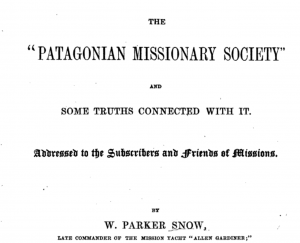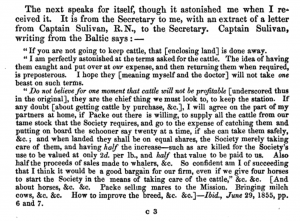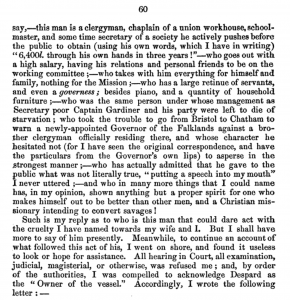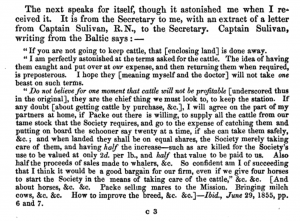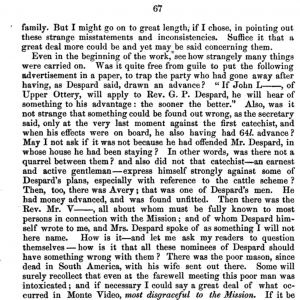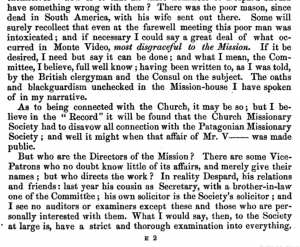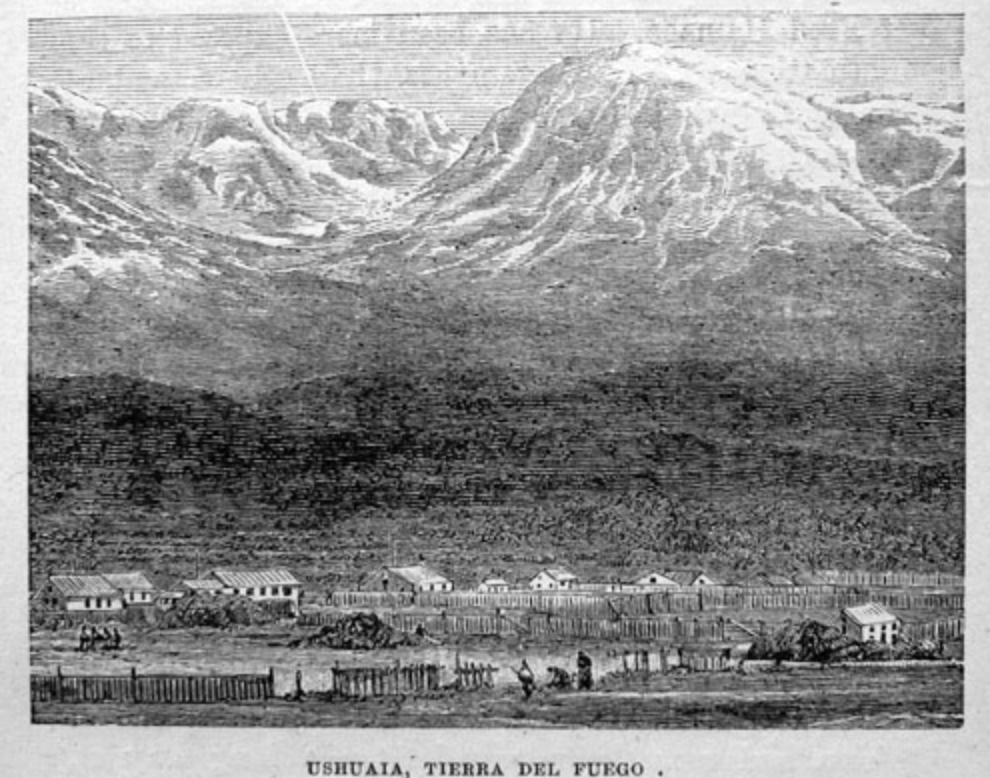
Ushuaia is often known as the southernmost city in the world, given its location in Tierra del Fuego, an archipelago on the tip of South America. Indeed, Ushuaia embraces this characterization, with signs proclaiming its status as “El fin del mundo” (The end of the world). The area was first settled by British missionaries despite being formally owned by Argentina. It has always been a relatively barren place, known for its difficult-to-live-in conditions. In fact, Tierra del Fuego, the archipelago on which Ushuaia is built, was originally named the land of fire for the columns of smoke and fire that European settlers first saw when approaching the archipelago. Estancia Harberton is one of the first structures in the area — a former cattle farm founded in the late 1880s by Anglican missionary Thomas Bridges.
As for Estancia Harberton in particular, its history is long, from originally being a missionary’s home to a cattle farm. The land in Tierra del Fuego required significant labor and the laborers were plagued by outbreaks of typhoid and other diseases. Furthermore, dangerous and inconsistent weather at the bottom of the world meant the property was oftentimes isolated. Key to the survival of the property was interactions with native people, who were experts in the region and able to provide extensive support. Currently the property serves as a reminder of the European roots in the region and their lasting impact, from the whale carcasses left over from whalers to farming structures used in the wool-harvesting days.
Estancia Harberton
Estancia Harberton, in Ushuaia, Tierra del Fuego, is currently owned by Thomas Bridges’ great great granddaughter. It serves as a tourist destination which includes a museum providing information on settlement and missions in the area as well as maintaining its old shearing sheds, sawmill, workshops and cattle pens. The property was named a National Historic Monument in 1999, and was formerly a sheep farm up until the 1990’s. BBC Travel in Tierra Del Fuego Article

The Yaghans were moved off their land, into, typically, missionary camps and large estates and ranches. Their former lifestyle was nomadic – reliant on traveling by canoe and consuming seafood. Societal stratification was practically nonexistent as family units were largely self-sufficient and individual. Moreover, females were often treated similarly to males and served a large role in obtaining sustenance for the family. The chart to the left, largely based on observations of European settlers, show that the population of the Yaghan people declines over time.
British exploration of the region began in 1826, when British survey ship HMS Beagle travelled through the Magellan Strait. Following these explorations, motivations to colonize the area were economical, based on seal- hunting and the discovery of gold. Along with this influx of settlers in the mid-1800s came missionaries, like Thomas Bridges, who sought to both spread Christianity and establish claims to the area.
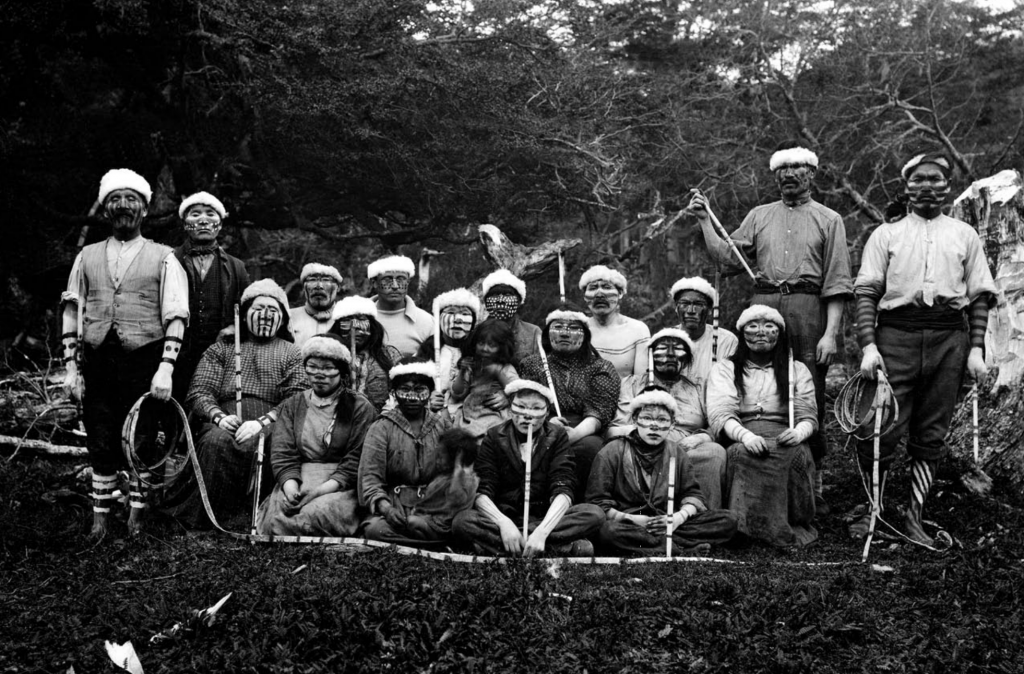
Christian Missions in South America
The author of this drawing stated “We saw two Fuegian women and a child, but none of us were attracted by their beauty or by the mats of black hair, like horsehair, hanging over their faces” in an 1876 article describing successes in converting natives to Christianity in Tierra del Fuego.
Image taken from Churchman’s Monthly Penny Magazine, and Guide to Christian Faith
Reverend Thomas Bridges “is referred to in official histories as ‘the father of Tierra del Fuego.’” This is likely attributable to his contributions to recorded history and relationship with the Yaghan people, the original inhabitants of the area. He had a very interactive approach to working with the natives and spreading religion. Bridges was likewise a part of the Patagonian Missionary Society, a group which sent clergymen, resources, and ranchers into Patagonia.
Thomas Bridges’ work represented a shift in native-European relations as he made clear efforts to learn their language and culture. He began the Yahgan Dictionary: Language of the Yámana people of Tierra del Fuego through frequent communication and interactions. Carefully, Bridges documents all of the intricacies of the Yahgan language, from notable use of adverbs to lack of terms for certain animals. He was motivated to translate and create this dictionary by religion; translating the Bible was a crucial piece in spreading Christianity and civilizing indigenous populations.
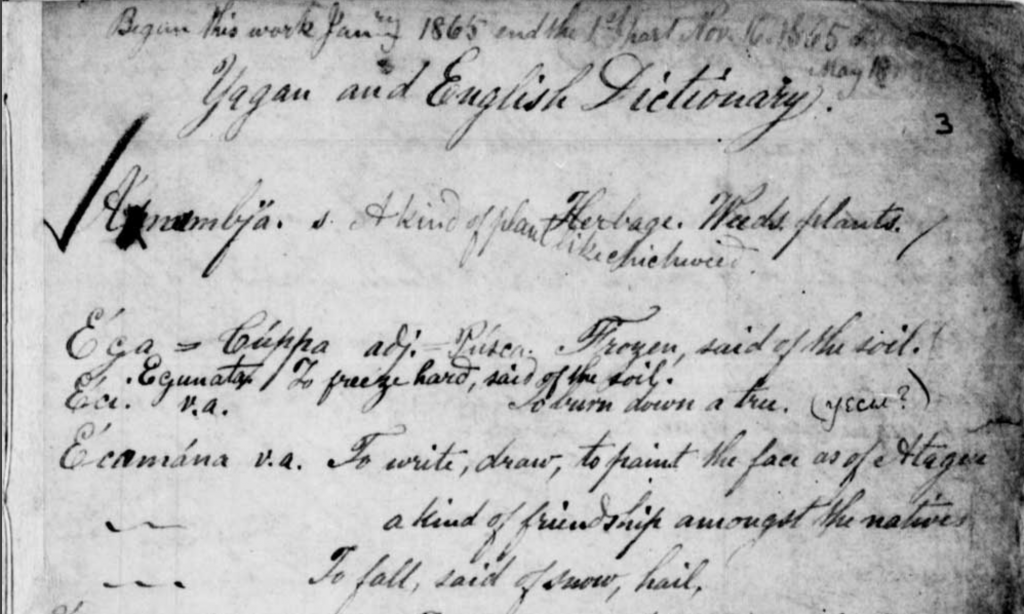
Indeed, Christian missionaries were often seen in the region, from the Northern regions of Patagonia to Tierra del Fuego, even forming the Patagonian Missionary Society. An 1876 news article in a Christian faith magazine documents the perceived successes in South American, indicated, at least in Tierra del Fuego, by more visibly pleasing (i.e. refined) natives, improved manners, and Mr. Bridges request to confirm six more natives. The article continues, stating, “The Church in Tierra del Fuego has, I hope, now a root of itself.” The spread of religion is crucial to the Church’s success, however, also provides a means for European powers to colonize and claim land through the erasure of pre-existing cultures. Interestingly, sixteen years prior to that article being written, an 1860 article in The Missionary Magazine reported progress in teaching “Christian doctrines and practice, and [preparing natives] for future usefulness”, indicating that the natives were not only vessels for Christian principles, but a capable and useable resource.
Motives and Necessities
Motives and Necessities
The realities of living in Tierra del Fuego, a well-known relatively inhospitable region, proved a challenge for European settlers. The promise of natives ready for conversion and land prime for ranching was enticing. However, there were a variety of players in this game, from missionaries to gold-seekers and hunters. They all fought for land and access in addition to sovereignty in Ushuaia and greater Tierra del Fuego.
Missionaries face a complicated role when coming to a new land. They are not just temporary visitors, but clergymen who hope to stay and continue to spread their faith quite literally throughout the land. This inevitably leads to the taking of land and construction of some sort of economy. Their successes, failures, and profits all critical in maintaining a presence in Tierra del Fuego. Some sources sing their praises where others tie their existence in the region to exploitation of land, indigenous people, and resources.
When analyzing the interactions and intentions of missionaries, it is important to recognize the authors of these sources. This first one, the “”Records of the South American Missionary Society, or Fifty years work of the Church of England in South America” was written by members of the Missionary Society. They report their experiences in the land of fire as both dismal and successful. Writers oftentimes express remorse and sadness at the dwindling native population. Indeed, religious rites were more often carried out on the dead than the living.
Looking at reports from this collection of records, there is a noticeable twinge of superiority to the texts written by English missionaries. For example, Waite Hockin Stirling said, “All this pleased and made me hopeful. It is not, we must allow, a slight change which has taken place in the character of the natives of these parts when we contrast the peaceful development of our plans, now in their very midst, with the fitful, hesitative, and timid efforts we were compelled by their former savage habits to put forth.” This is typical for the time period, a perhaps mistaken view but very normalized and to be expected.

William Parker Snow recorded his many interactions as a captain on a ship headed to Patagonia. From noting misogyny to the missionaries’ questionable motives in coming to the archipelago, he makes sure to show the events on the ship as they really occurred. He calls out the superficiality of the missionaries and their frequent search for money and success rather than the humble lifestyles they ought to lead through documenting letters with other captains, communication between members of the Patagonian Missionary Society, and more. Furthermore, the letters tell not of a story of religious zeal, but one where the Society is providing for cattle, carefully monitoring finances, and managing land, cattle and herdsmen. Natives were not always considered a group to be converted, he says, but an accessible workforce for cattle farms. This portrayal of missionaries is quite negative, implying a devious intent in coming to South America.
While “the Society never promulgated the notion that a cattle colony was to be established, wherein any one belonging to the Committee was to have a half-share, and the affair to be made with a profitable speculation with natives to work there while they ‘could not get away’”. Moreover, Snow emphasizes the fraudulent nature of the missionaries, wondering how “a teacher of the mild and merciful doctrine of a meek, lowly, and ever-loving Saviour” could end up living in an enormous plantation like home and “takes with him everything for himself and family, nothing for the Mission; who has a large retinue of servants, and even a governess”. Finally, he states that anyone who actually believes the society to be a benevolent, solely religious group is ignorant. With all these scathing comments, it seems that the missions to Tierra del Fuego were perhaps not as well-meaning as they appeared on the surface.

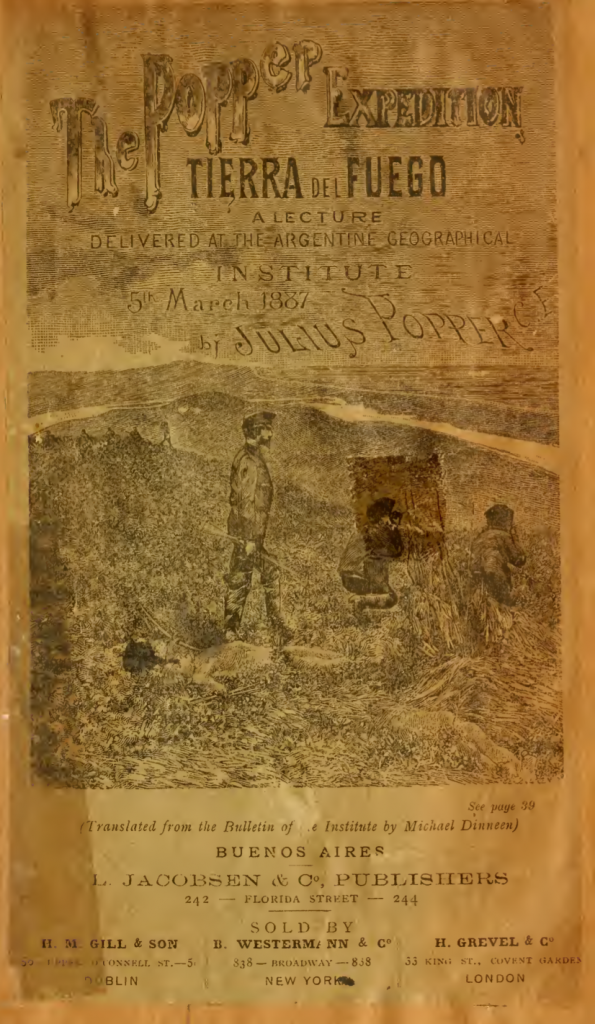
One recorded experience, in 1887, was written by Julius Popper who attributed his shaky interactions with natives to prior events, essentially putting missionaries in the spotlight, stating that a national state-building and religious efforts joined forces in Ushuaia to take over land and profit:
“Some few years ago the British Consul at Punta Arenas, Mr. Stubenrauch, on seeing the beautiful plains at Gente Grande Bay, resolved to establish a sheep farm there, and had some houses built; he enclosed large spaces with wire fences, and carried over some sheep from the Falkland Islands, placing a missionary from the islands in charge of the farm.”
However, Popper’s own history is not to be neglected. He was essentially in direct competition with both the British government and missionaries as a Romanian gold miner. He sought the land that the missionaries and British government jointly worked to attain and thus portrayed them in a negative a deceitful light. This is not to say that every missionary came with the sole intention of converting natives, but it does display the impact of bias on historical reports. Moreover, Popper fancied Tierra del Fuego as his own, even going so far as to meld and inscribe his coins in November of 1889. These gold medallions stated “Tierra del Fuego – Popper – 1889”. Finally, Popper was often given land by the Argentine government, frequenting Buenos Aires to persuade government officials of the gain he stood to make, while he often times sought to kill natives and never bothered to count the land he was given, unabashedly taking land where he wanted.
Therefore, while Popper has reported on the use of land by missionaries, he does not have a right to incriminate them for wrongdoing as he is doing the same, if not worse, with his intentional killings of Yaghan people. On the other hand, The elimination of cultural rituals additionally served a role in conquering land, if accidental. Once the Yahgan’s population dwindled more and more, and their culture nearly disappeared, settlers found it far easier to claim land. Now a defenseless population, “when the ranchers took possession of the land, they said nothing, because they were no longer savages but had been civilized by the English.” Overall, the attempted conversion of Yahgans to Christianity and literal conversion of land to sheep ranches marked the end in the wild nature of Tierra del Fuego and turned it into another European endeavor for state building and profit.
Overall moral, deceptive and disingenuous efforts all coexisted in the rise of Ushuaia as a British outpost filled with cattle farms and schools. The region tells a tale of European competition, native struggles, and claims of foreign land; all three of which are much more nuanced than they seem on the surface. After all, it is said that the winner is the one who writes history, so it may not ever truly be known what really occurred. Equipped with this knowledge, it is only that much more crucial to look at from as many perspectives as possible with awareness of the writer themself.
Further Readings
“Patagonia Bookshelf.” Fifty years’ work of the Church of England in South America, excerpts. Duncan Campbell & Gladys Grace. Accessed April 27, 2020. https://patlibros.org/yam/pref- eng.php.
“A “GODLESS” TRIBE’S IDEA OF GOD.” Catholic World, 01, 1923, 536-538, https://search-proquest-com.ezproxy.princeton.edu/docview/1908847653?accountid=13314.
Bennett, Philip. “PROGRESS BEATS A PATH TO THE LAND OF FIRE TIERRA DEL FUEGO DEBATES CHANGE: [THIRD EDITION].” Boston Globe (Pre-1997 Fulltext), Jul 12, 1989. https://search-proquest- com.ezproxy.princeton.edu/docview/294521879?accountid=13314.
Meghji, Shafik. “Travel – The Remote Ranch at the Bottom of the World.” BBC. BBC, September 11, 2017. http://www.bbc.com/travel/story/20170910-the-remote-ranch-at-the- bottom-of-the-world.
“Patagonia Bookshelf.” English-Yahgan Dictionary : Preface by Thomas Bridges. Duncan Campbell & Gladys Grace. Accessed April 27, 2020. https://patlibros.org/yam/pref- eng.php.
“PATAGONIAN, OR SOUTH AMERICAN MISSIONARY SOCIETY.” The Missionary Magazine (1850-1872), 04, 1860, 116, https://search-proquest- com.ezproxy.princeton.edu/docview/124324752?accountid=13314.
POPPER, Julius, and Michael DINNEEN. The Popper Expedition, Tierra Del Fuego. A Lecture Delivered at the Argentine Geographical Institute … Translated from the Bulletin of the Institute by M. Dinneen. Buenos Aires: L. Jacobsen & Co., 1887.
RHODEN, LAURA BARBAS. “Ecology, Coloniality, Modernity: Argentine Fictions of Tierra Del Fuego.” Mosaic: An Interdisciplinary Critical Journal 41, no. 1 (2008): 1-18. Accessed April 28, 2020. www.jstor.org/stable/90011642.
“South American Missions.” Churchman’s Monthly Penny Magazine, and Guide to Christian Faith (New Series), 10, 1876, 228-231, https://search-proquest- com.ezproxy.princeton.edu/docview/2203288557?accountid=13314.
Snow, William Parker. The “Patagonian Missionary Society” and Some Truths Connected with It: Addressed to the Subscribers and Friends of Missions. London: Piper, Stephenson, and Spence, 1858.
“YAGHAN’S, EXPLORERS AND SETTLERS: 10,000 Years of Southern Tierra Del Fuego Archipelago History.” Ministry of Education Chile. Santiago – Chile, December 2008.
Teller, Matthew. “A Patagonian Puzzle: Why Does No-One Stay to Explore the World’s Southernmost City?” Adventure.com, 21 Aug. 2018, adventure.com/ushuaia-patagonia-argentina/.

